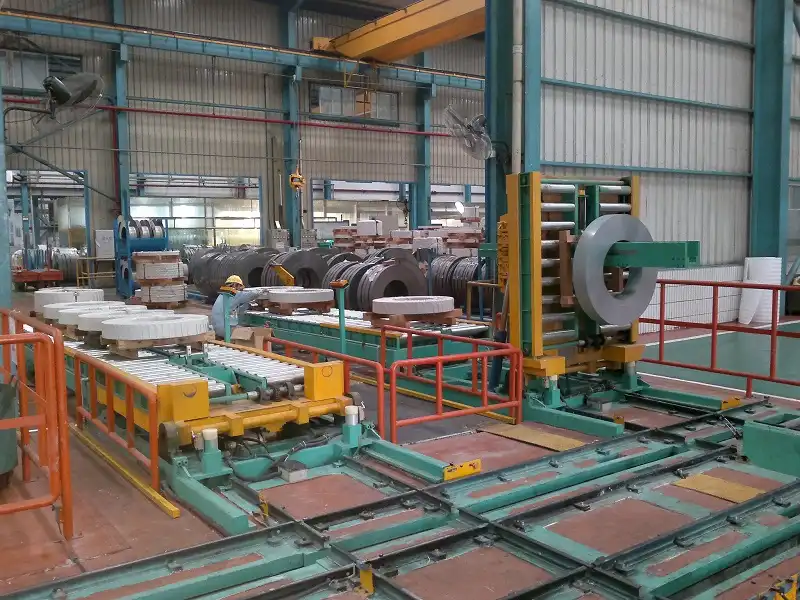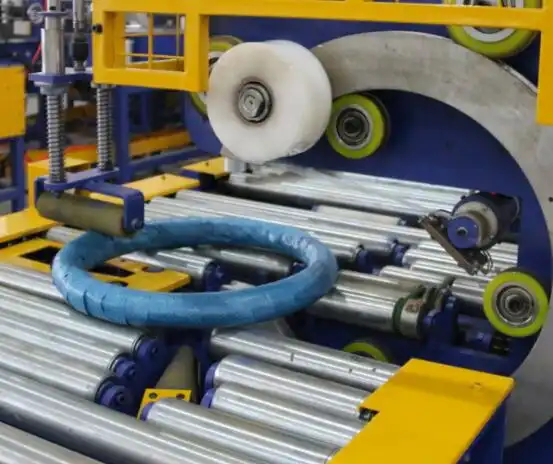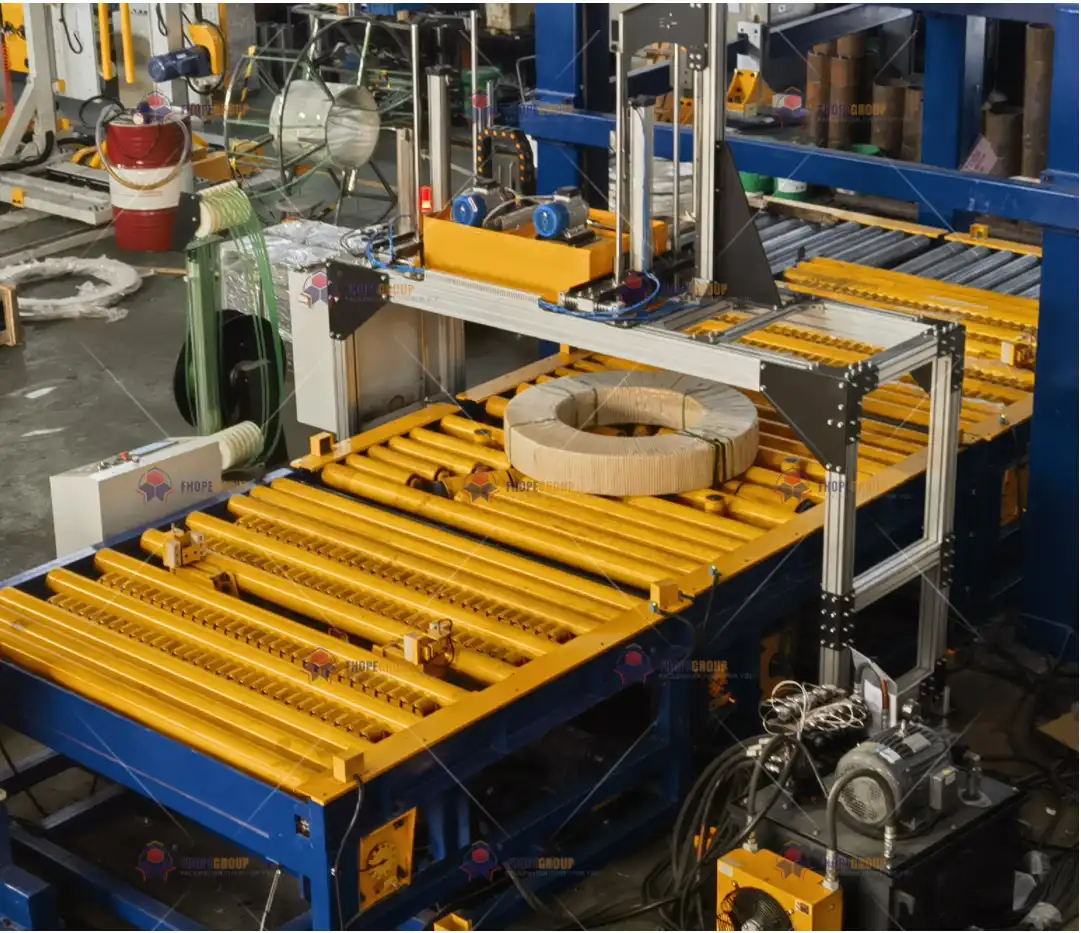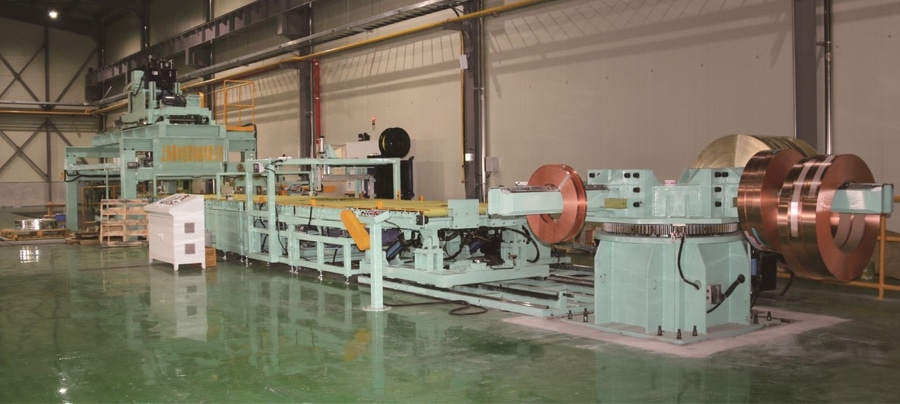Running a steel mill in Spain today is a high-stakes game. You are constantly battling volatile energy prices that can wipe out your margins overnight. Your most reliable equipment, the workhorses of the factory floor, are now over 15 years old and showing their age with frequent breakdowns. On top of that, you face growing pressure from the government to meet stricter environmental standards. This pressure creates a difficult situation. You need to invest, but every euro must be justified with a clear return.
Spanish steel producers are turning to automatic coil packing lines because they offer a direct and powerful solution to these modern challenges. These systems reduce dependency on manual labor, cutting costs and improving safety. They enhance product protection through consistent, high-quality wrapping, which minimizes damage during shipping. Most importantly, they increase overall throughput by eliminating end-of-line bottlenecks and integrate seamlessly into the digital, data-driven factory of the future. This strategic upgrade is no longer a luxury; it is a necessity for survival and growth.

I have walked through countless steel plants, both in Spain and across the globe. I have spoken with owners like you, people who carry the weight of the entire operation on their shoulders. The story is often the same. The challenges are real, and the need for smart, effective solutions is urgent. It’s not just about buying a new machine. It's about finding a partner who understands your problems and can provide a solution that works for the long term. Let's look at the real questions you are likely asking and find some clear answers.
How can automatic lines tackle rising labor and energy costs?
You see the numbers every month. The payroll for your packing team keeps rising, and finding skilled, reliable workers is getting harder. Your energy bill swings wildly, making it impossible to predict production costs with any certainty. It feels like you are losing control over your two biggest operational expenses. This constant financial pressure makes strategic planning difficult and eats directly into your profitability.
An automatic coil packing line directly counters these rising costs. It dramatically reduces the need for manual labor, often reassigning multiple workers from repetitive, physically demanding tasks to more valuable roles. This lowers your wage bill and associated costs. At the same time, these modern lines are engineered for energy efficiency. They use smart motors and optimized cycles to consume less power per coil packed, providing a stable, predictable energy cost that you can count on.

When I first started as an engineer, the focus was purely on mechanical speed. Today, the conversation is completely different. It's about total operational efficiency. A client of mine in Andalusia was running three manual packing stations per shift, with two workers at each station. That's six people just to wrap and strap coils. The work was slow, and the quality was inconsistent. When we started talking about automation, his first concern was the upfront cost. He wasn't sure if he could justify it. So, we sat down and did the math together, looking beyond just the price of the machine.
The Labor Cost Equation
The cost of an employee is not just their salary. You have to account for social security contributions, insurance, training, and paid time off. There is also the hidden cost of human error and potential workplace injuries, which can be extremely expensive. An automated line runs 24/7 with minimal supervision. It doesn't get tired, it doesn't need breaks, and its performance is perfectly consistent. By replacing manual labor, you are not just cutting salaries; you are removing a whole layer of variable and unpredictable costs from your operation. This allows you to re-deploy your valuable team members to roles that require human intelligence, like quality control or machine maintenance, increasing their job satisfaction and value to the company.
Optimizing Energy and Material Use
Legacy equipment was often built with large, inefficient motors that ran at full power continuously. Modern automated lines are much smarter. They use variable frequency drives (VFDs) that adjust motor speed and power consumption based on the immediate need. The system only uses peak power during the wrapping or strapping cycle, then drops to a minimal level. Furthermore, automation brings incredible precision to material consumption. A human operator might overlap stretch film by 50% one time and 70% the next. An automated wrapper is programmed for the exact overlap required, using the minimum amount of material to achieve maximum protection. Over thousands of coils, this small saving per coil adds up to a significant reduction in your consumable costs.
| Cost Factor | Manual Packing Process | Automatic Packing Line |
|---|---|---|
| Labor | High (2-4 operators per shift) | Low (1 supervisor for multiple lines) |
| Energy | Moderate, often inefficient | Low, optimized for each cycle |
| Material Waste | High (10-15% overuse) | Very Low (<2% overuse) |
| Training Costs | Ongoing, high turnover | Minimal, one-time training |
| Injury Risk | High (back strain, repetitive motion) | Extremely Low |
Do modern packing lines truly improve product quality and safety?
You ship a perfectly manufactured steel coil, but it arrives at your customer's facility with rust spots or a crushed edge. That single failure can damage a relationship you've spent years building. At your own plant, the packing area is a known danger zone. The risk of a worker straining their back, getting caught in a strapping machine, or being hit by a forklift is a constant worry. These issues of quality and safety are not just operational problems; they are direct threats to your business's reputation and your employees' well-being.
Yes, a modern packing line makes a massive difference in both product quality and worker safety. For quality, automation ensures every single coil is packaged to the exact same high standard. The wrapping tension is perfect, the material placement is precise, and the seal is complete. This provides superior protection against moisture, dust, and physical impacts during transit. For safety, the improvement is even more dramatic. The entire hazardous process is contained within a guarded, automated system. Workers are removed from the dangerous "hot zone," virtually eliminating the most common types of packing-related injuries.

I remember visiting a steel processor near Valencia. Their warehouse had a "re-work" corner filled with coils that had been damaged by poor packaging. Water had seeped in, causing rust. Straps were too tight, damaging the edges. It was a clear waste of money and material. The plant manager was frustrated because no matter how much he trained his team, the results were always inconsistent. This is a classic problem that manual processes simply cannot solve. Humans, even the best ones, have good days and bad days. A machine does not.
Consistency is King for Product Protection
The key to protecting a steel coil is a complete and consistent barrier against the elements. An automatic line achieves this beautifully.
- Through-the-eye wrapping: The machine passes the packaging material (like VCI paper or stretch film) through the center of the coil and around the outside. This completely cocoons the product, leaving no gaps for moisture to enter.
- Controlled Tension: The system maintains a constant, programmable tension on the film. This is critical. Too little tension and the wrap is loose; too much and it can damage the coil edges. Automation gets it right every time.
- Precision Overlap: The system ensures a specific, consistent overlap of the packaging material, creating a multi-layered shell that is highly resistant to punctures and tears. This level of precision is simply not possible by hand.
Designing for a Safer Workplace
Safety is not an afterthought in modern machine design; it is a core principle. Automated packing lines are built as self-contained cells.
- Safety Fencing: The entire area is enclosed by physical guards, preventing anyone from accidentally walking into the path of moving machinery.
- Light Curtains: These infrared beams create an invisible safety barrier. If a person or object breaks the beam, the entire system stops instantly.
- Emergency Stops: E-stops are placed at multiple, easily accessible points around the line.
- Process Automation: The machine handles all the heavy lifting, turning, and strapping. This eliminates the manual tasks that lead to the most severe injuries, like back problems from lifting or hand injuries from strapping tools.
| Factor | Manual Packing Process | Automatic Packing Line |
|---|---|---|
| Package Consistency | Low to Medium | High and Repeatable |
| Moisture Protection | Inconsistent, prone to gaps | Excellent, full cocoon wrap |
| Edge Damage Risk | High, from overtightening | Low, controlled tension |
| Worker Injury Rate | High | Near-zero |
| Ergonomic Strain | High (Repetitive tasks) | Eliminated |
What is the real ROI of upgrading to an automated coil packing system?
As a business owner, you are responsible for every major capital expenditure. A new automated packing line is a significant investment, and the initial price can seem high. You have to be absolutely certain that the investment will pay for itself and deliver a real, measurable return to your bottom line. It's easy to hesitate, fearing that the promised benefits won't materialize and you'll be left with an expensive machine that doesn't solve your core problems.
The real Return on Investment (ROI) for an automated system goes far beyond just labor savings. A proper analysis shows a rapid payback, typically within two to four years, driven by a combination of factors. These include a dramatic increase in throughput by removing the packaging bottleneck, a sharp reduction in product damage claims, lower insurance premiums due to a safer workplace, and reduced costs for both labor and packaging materials. The investment transforms a cost center into a source of efficiency and profit.
I've learned that the best way to show the value is to work through the numbers with my clients. We don't just talk about features; we talk about euros and cents. I once worked with a CEO, much like Javier from the persona, who was running his production line at only 80% capacity. Why? Because his manual packing team couldn't keep up. Coils were piling up on the floor, waiting to be wrapped. His multi-million euro production line was being held back by a simple, manual process at the end. The cost of that lost production was far greater than the cost of an automated solution.
Calculating the Tangible Returns
The ROI calculation is straightforward. It’s the total financial gain from the investment minus the cost of the investment, divided by the cost of the investment. Let's break down the gains.
- Labor Savings: This is the easiest to calculate. Take the number of workers you can reassign, multiply by their fully-loaded annual cost (salary + benefits + insurance).
- Material Savings: Calculate your current annual spending on stretch film, paper, and straps. A modern system can often reduce this by 10-20% through precision application.
- Throughput Gain: This is the hidden gem. If your packing line is the bottleneck, automation unlocks the true capacity of your entire plant. Calculate the value of the extra coils you can produce and ship each day.
- Damage Reduction: Look at your records for customer claims and credits due to shipping damage. A significant portion of this can be eliminated.
The Intangible, Yet Powerful, Returns
Not everything fits neatly into a spreadsheet. What is the value of your reputation? When a customer receives a perfectly packed, undamaged coil every single time, their confidence in you grows. They see you as a modern, reliable, high-quality supplier. What is the value of improved employee morale? Moving your team from dangerous, monotonous work to safer, more skilled positions shows that you value them. These intangible benefits lead to stronger customer loyalty and a more stable, motivated workforce—both of which are priceless for long-term success.
| ROI Component | Hypothetical Annual Figure (EUR) | Notes |
|---|---|---|
| Investment Cost | - €300,000 | One-time cost for the automated line |
| Labor Savings | + €120,000 | (3 workers x €40,000 fully-loaded cost) |
| Material Savings | + €15,000 | (15% reduction on €100,000 annual spend) |
| Throughput Gain | + €50,000 | (Value of increased production capacity) |
| Damage Reduction | + €5,000 | (Reduction in claims and re-work) |
| Total Annual Gain | + €190,000 | |
| Payback Period | ~1.58 Years | (€300,000 / €190,000) |
How does automation support digitalization and environmental goals?
You know that the future of your industry is both digital and green. Your biggest customers are starting to ask for full traceability data on their products. At the same time, Spanish and EU environmental regulations are becoming more demanding every year, pushing you to reduce your carbon footprint and waste. Your existing, aging equipment operates in isolation. It's an information black hole that can't connect to a modern factory management system, and it's certainly not designed for today's environmental standards.
Modern automation is the essential bridge to achieving your digitalization and environmental goals. These packing lines are built with sensors and connectivity in mind, integrating directly with your Manufacturing Execution Systems (MES) and ERP platforms. They provide the real-time data you need for full production visibility. Environmentally, they contribute by design. They operate with high energy efficiency and minimize the consumption and waste of packaging materials like plastic film, directly supporting your efforts to create a more sustainable and compliant operation.

During my journey from engineer to factory owner, I saw this shift happen firsthand. In the early days, a machine's only job was to perform a physical task. Now, its job is to perform a physical task and generate useful data. A modern packing line is an intelligent asset on your network. A client in the Basque Country recently installed one of our lines. Their primary goal was to provide a "digital passport" for each coil. Our system integrates with their scales and barcode scanners. It automatically records the coil ID, weight, dimensions, the time it was packed, and the exact packaging recipe used. This data is sent directly to their MES. When their customer scans the coil upon arrival, they have its entire history at their fingertips. This is the new standard of customer service.
The Data-Driven Packing Line
This is the core of Industry 4.0 in your plant. An automated line is no longer an island.
- MES/ERP Integration: The line's controller can communicate with your central factory software. You can send packaging orders directly to the machine, and the machine can send status updates and production data back.
- Full Traceability: By linking the packaging data to a unique coil ID, you create a complete digital record. This is invaluable for quality control, inventory management, and customer service. If a customer has a problem, you can instantly pull up the record and see exactly how it was handled.
- Predictive Maintenance: Sensors on the machine monitor motor health, cycle counts, and component wear. The system can alert you before a part fails, allowing you to schedule maintenance during planned downtime, not during a production crisis. This is a key part of reaching a 95% uptime goal.
A Greener Approach to Packaging
Being environmentally responsible is also good business. It reduces waste, lowers costs, and improves your corporate image.
- Reduced Plastic Waste: Stretch film is a major consumable. By applying it with precision-controlled tension and pre-stretch, an automated system can use up to 30% less film than a manual process while achieving a more secure wrap. This is a direct reduction in plastic waste.
- Energy Efficiency: As we discussed, modern motors and smart controls use significantly less electricity. Lowering your energy consumption directly reduces your factory's carbon footprint.
- Material Compatibility: These lines can be adapted to work with newer, more sustainable packaging materials, such as films with recycled content or biodegradable options, preparing you for the future of green packaging.
| Feature | Legacy Equipment | Modern Automated Line |
|---|---|---|
| Data Output | None | Full integration (MES, ERP) |
| Real-time Tracking | No | Yes (per coil tracking) |
| Predictive Maintenance | No (Run until failure) | Yes (Sensor-based alerts) |
| Material Waste | High | Minimized through precision |
| Energy Consumption | High and Inefficient | Low and Optimized |
My Insight
I didn't start SHJLPACK from a boardroom. I started on the factory floor as a young engineer. I spent years with my hands on the machines, learning what worked and what didn't. When I finally built my own factory, I faced the same pressures every owner does: controlling costs, pushing for quality, and keeping my team safe. I remember one specific challenge that defines my philosophy to this day.
We had a client, a family-owned steel service center. Their biggest problem was a bottleneck at the end of their slitting line. They could cut steel faster than they could pack it. Coils were piling up, shifts were running overtime just to clear the backlog, and the owner was incredibly stressed. Many suppliers came in and just tried to sell him their standard wrapping machine. They showed him brochures and quoted a price.
I took a different approach. I spent two days at his plant, not talking about my machines, but watching his process. I timed the manual packing cycle. I measured the floor space. I talked to the operators. I realized he didn't just need a wrapper; he needed a complete solution. He needed a conveyor to move the coil, a tilter to position it, a strapping machine to secure it, and then a wrapper to protect it.
We designed a compact, L-shaped line that fit perfectly in his limited space. We presented him not just with a price, but with a full analysis: his current cost per coil versus the new cost, his current throughput versus the projected throughput, and a clear ROI calculation. He saw that we understood his problem, not just his need for a machine. We became his partner, not just his supplier. Within six months of installation, his bottleneck was gone. He was able to add a second shift, and his business grew by 40% in two years. That experience taught me everything. It’s why our slogan is "TOTAL SOLUTION FOR WRAPPING MACHINE" and why my mission now is to share this knowledge. The goal is to help you succeed, because your success is our success.
Conclusion
For Spanish steel producers, automatic coil packing isn't an expense. It's a strategic investment in efficiency, safety, quality, and future-readiness. It is the total solution.





